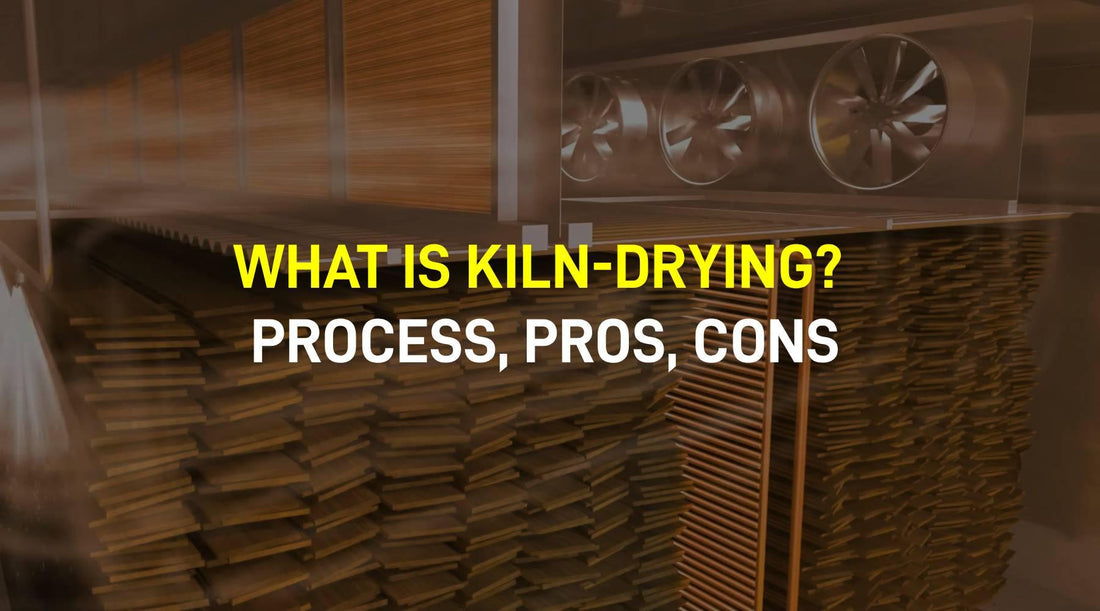
What Is Kiln-Drying? How Does It Work?
Kiln drying is the best process of producing quality firewood logs and briquettes for household heating. The method involves baking wet logs in an industrial oven (aka a kiln) using controlled heat and specialised fans for optimal airflow.
While more expensive for the manufacturer, kiln-drying results in high-quality logs that are low in moisture, burn efficiently, and produce little to no smoke. Kiln-dried logs emit far less particulate matter than conventional seasoned logs, which makes them far better for the environment. They also produce very little creosote, which means that you won't have to have your chimney swept as often (read our article on hiring a chimney sweep).
Thus, choosing kiln-dried firewood can significantly improve the efficiency of your wood-burning appliance and prolong its life. It will also improve the quality of the air you breathe during the heating season, which is particularly important for people with respiratory issues.
You May Also Like:
Cherry Logs & Firewood: All You Need to Know About Burning Cherry
Log Burner Installation Guide 2024 | Complete Cost & Process Overview
Wood Moisture Meters: How to Choose, Buy, and Use
Importance of Controlling Moisture Content
As you may know from our article about wet wood, proper moisture content is critical for both logs and wood briquettes. Kiln drying ensures that the wood reaches optimal moisture levels, which increases its efficiency and heat output. Too much moisture can lead to your logs being difficult to light, producing a lot of smoke, and depositing large amounts of creosote inside your flue.
The Process of Kiln Drying
Kiln-drying firewood logs is both an art and a science. Here at Lekto, we use a special five-step process to manufacture our kiln-dried logs. We use the same exact logs for all three varieties of logs we sell, namely birch, oak, and ash.
- Stacking and Sorting. Wet logs are first sorted and then stacked in a special formation with spacers that ensure optimal air circulation. While time-consuming, this setup ensures the most even, consistent drying results possible. It also prevents common kiln-drying defects, such as warping and splitting.
- Pre-Conditioning. The kiln is slowly and gradually warmed up to bring the wood's surface temperature to a pre-determined level. This gradual warming helps avoid stress points and cracks forming in the wood from rapid heating.
- Fanning. Once the logs are pre-heated, industrial fans are turned on to ensure uniform drying throughout the kiln and get rid of excess moisture as soon as possible. This phase continues until the wood reaches a target moisture content. Most kilns target the 20% moisture level prescribed by Defra. At Lekto, we go above and beyond, frequently leaving our logs in the kiln until we see single-digit moisture levels.
- Conditioning. Once the fanning stage is over, we increase the moisture in the kiln slightly. This helps relieve internal stresses in the wood, prevent cracking, and ensure that the wood's internal and external moisture levels are balanced.
- Cooling. The finished product is gradually cooled to stabilize it before removing it from the kiln. This process cannot be rushed because hot logs are prone to cracking and reabsorbing moisture if not cooled sufficiently.
Kiln-Drying vs Air Drying (Seasoning)
Historically, wood was usually air-dried. This process hasn't changed much in the last few centuries and involves stacking the wood in a well-ventilated outdoor area, covering it with water-resistant sheeting, and waiting for it to gradually dry out on its own.
The primary benefit of seasoning is cost. The manufacturer doesn't have to pay for expensive machinery and the labour of experienced technicians. All you need is space and the most basic labour imaginable. As a result, seasoned logs are often sold at a slightly lower cost than kiln-dried logs.
So, is it a good idea to save a few pounds by choosing seasoned logs?
We wouldn't. While seasoning can theoretically produce very good results, achieving extra low moisture levels with it can take over two years in British climes (especially with denser wood species, such as oak). And as the primary benefit of kiln-drying firewood is cost, most suppliers will start selling their logs the moment they're dry enough to be legally sold in the UK (read more about Defra's Ready to Burn regulation).
As a result, choosing cheaper logs is usually a false economy. You quickly recoup the extra costs of kiln-dried logs in the form of increased efficiency and less frequent visits from the chimney sweep.
And that's not even mentioning the elephant in the room. Seasoned logs are not safe to store indoors as they're often home to various pests, fungi, and mould. The kiln-drying process gets rid of all of these, making them 100% safe to store indoors and even use as decoration.
Frequently Asked Questions About Kiln-Drying
What is kiln-drying?
Kiln drying is a process of reducing the moisture content in wood by placing it in an industrial oven (aka a kiln) and using a combination of controlled heat and airflow to dry it out. This method produces high-quality firewood logs and briquettes that burn efficiently, produce less smoke, and emit fewer particulates, making them better for the environment and indoor air quality.
How long does kiln drying take?
The kiln drying process duration can vary depending on the type of wood and its initial moisture content. Generally, the process involves several stages, including stacking and sorting, pre-conditioning, fanning, conditioning, and cooling, to ensure the wood reaches optimal moisture levels, typically below 20% and often in the single digits at Lekto.
How does kiln-drying wood work?
Kiln drying involves a five-step process:
- Stacking and Sorting. Wet logs are sorted and stacked to allow optimal air circulation.
- Pre-Conditioning. The kiln is gradually warmed to a pre-determined temperature to avoid wood stress.
- Fanning. Industrial fans ensure uniform drying and remove excess moisture.
- Conditioning. Moisture is slightly increased to balance internal and external wood moisture levels.
- Cooling. The wood is slowly cooled to stabilize it before removal from the kiln.
How to build a wood-drying kiln?
Building a wood-drying kiln requires a well-insulated chamber, a heat source (such as electric heaters or a wood-burning stove), and fans for air circulation. The process involves:
- Designing a chamber with good insulation.
- Installing a heat source to maintain a consistent temperature.
- Adding fans to circulate air evenly.
- Incorporating vents for moisture control.
- Ensuring safety features to manage heat and prevent fire hazards.
How to build a homemade kiln for drying wood?
For a homemade kiln, you can use a smaller, simpler setup:
- Construct a wooden frame and insulate it.
- Use a heat source like incandescent bulbs or small heaters.
- Install a fan to ensure air circulation.
- Use a hygrometer to monitor moisture levels.
- Keep the setup in a dry, ventilated area.

